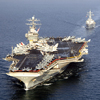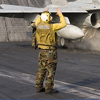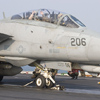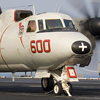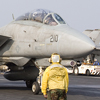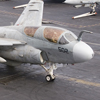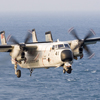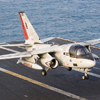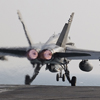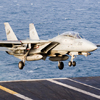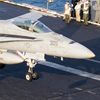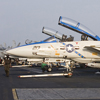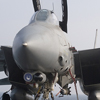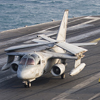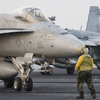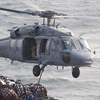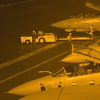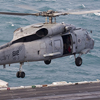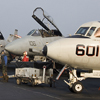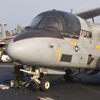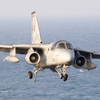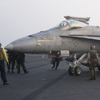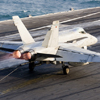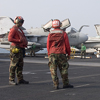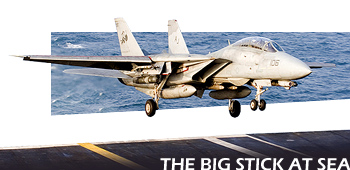
USS Theodore Roosevelt Feature Report
January
Imagine you're flying a multi-million dollar jet, it's not 'fat for gas', it's night-time and you still have live bombs aboard, you're tired and you need to land, but your homebase is little more than a postage stamp in the middle of a rough, rolling temperamental sea. Yet this scenario is one of those faced almost everyday by the aircrews of America's Big Stick, the USS Theodore Roosevelt (CVN-71) during its current operations in the Persian Gulf.
spent a day onboard "The Big Stick". All photography by the author unless otherwise stated.
Each day, the aircraft of the ship's huge Air Wing - Carrier Air Wing 8 - including Tomcats, Hornets, Prowlers, Hawkeyes as well as the ubiquitous little Vikings are sent blasting off catapults into the air for missions lasting up to six hours, either over the Persian Gulf for Maritime Security Operations (MSOs), or deep into Iraq as part of the continuing campaign against insurgents operating in Iraq as part of Operation Steel Curtain.
Since the ship began operations in September, hundreds of sorties have been flown and thousands of pounds worth of ordnance have been expended in support of the troops on the ground and despite their ship being hundreds of miles off shore, surrounded by the safety of the vast open sea, all on board say they want to do their best to make the lives of their compatriots on the ground, in both the American and Coalition forces, as comfortable and safe as possible.
Even during the relative peace of the Iraqi Parliamentary elections, which occurred during the author's visit to the ship, missions continued around the clock.
Among those taking on the task are the Tomcat crews from VF-213 - 'The Black Lions', and VF-31 - 'The Tomcatters'. This cruise is a proud one for them as they take the famous F-14 on its last ever operational cruise. Once the carrier returns home in early 2006, their much loved and revered F-14 Tomcats will be taken away from them to be replaced by the more modern, and cost-effective F/A-18E/F Super Hornet.
Lt Matt Nieswand, 26, from New Jersey who serves with VF-213 was the last ever pilot to be trained on the Tomcat at NAS Oceana, and will have spent just a year on the 'movie star' machine before it's finally retired and he will transition to the Super Hornet.
"It was a strange feeling that everyone was saying their goodbyes and farewells to an aircraft I was learning to fly. For me, this is the ultimate aircraft, when you think of the Navy and its aircraft carriers this is the aircraft that people think of, and that's why I wanted to fly it.
"It's going to be sad to see the aircraft go, nothing really compares with this machine, especially in the long-range attack role, there are very few that can match it.
"The flying over Iraq has been challenging, and even though we are about to retire the jet, we are still adding new pieces of technology to it.
"Currently we are using a system which hooks up the Infra-Red and targeting systems, which allow the guys on the ground to see what we see up there, so we are still at that cutting edge.
"But nothing can prepare you for landing at night - day landings are pretty easy by comparison, but those at night still send your heart racing."
Missions by the Air Wing's Tomcats have seen the jets carrying a range of loads, often asymmetric with 500lb GPS-guided JDAMS and laser-guided bombs sitting side-by-side on the belly while a LANTIRN pod is usually fitted on pylons in the wing root.
Some have lasted five or six hours, involving two or three refuelling prods either from the carrier's own Viking squadron VS-24 Scouts, or from the many Coalition tankers based in the region. Recent missions even saw Tomcats strafing insurgent positions west of Baghdad called in by Marine Forward Air Controllers. One incident involving a Tomcat crew from VF-31 was the talk of the ship during UKAR's visit when their jet strafed insurgents who were within seconds of firing Rocket Propelled Grenades at a Marine sniper position.
Very few of these missions would be possible without the support given by the crews aboard the Air Wing's Hawkeyes, Prowlers and of course the Lockheed Viking whose invaluable ability to off-load fuel to the most thirsty of Tomcats and Hornets.
However, the Viking faces a bleak future in the US Navy, its old role of anti-submarine warfare is considered obsolete and its refuelling role will soon be replaced by the 'Five Wet at Sunset' - configured Super Hornet. In fact nowhere is this more apparent than onboard the Roosevelt, whose Viking squadron, VS-24 Scouts will be disbanded on its return to the United States.
Lt Clay Waddill, 27 has been a Viking crew member for four years, and he says he will look back on his career with the Viking with great pride.
"When I joined the Navy, I have to admit I hadn't really heard of the Viking, but when I found out a little bit more about it, I realised that this was a community I wanted to be part of.
"Our original role is long gone, it was decided that there was no need for it anymore, but our new role is just as important.
"It's not the most attractive aircraft on the carrier, but it's certainly one of the most impressive flyers, but the aircraft earns its nickname the Hoover very well because of the noise it makes, but it's a great aircraft and a great community."
In fact, despite being one of the less romantic aircraft onboard, its often been a sight for the sore eyes of fighter aviators, particularly over Iraq, where aircraft may need to top-off their tanks three or four times.
If you think being in the air sounds unforgiving, spare a thought for the thousands of men and women on the flight deck and down below, whose sole job is to keep the Air Wing functioning, from the chefs, who keep stomachs full with a breathtaking range of foods to the sailors who work in the laundries, to those keeping the ship moving in the engine rooms and reactor departments right up to the technicians, mechanics and air traffic controllers.
They're not just on the carrier either; there are also many sailors onboard the warships and submarines which give the carrier its 'ring of steel' protection and of course the re-supply ships and crews of the Carrier Onboard Delivery (COD) Greyhound aircraft from VRC-40, who have been flying record numbers of sorties to deliver the eagerly awaited mail and parts from shore.
To witness all this in action is a breath-taking experience and difficult to take in, in just 24 hours. I would like to thank the United States Navy and its Fifth Fleet Public Affairs team as well as the Public Affairs Officers aboard the USS Theodore Roosevelt for all the hard work they did in getting me aboard the ship. It was an experience I will never forget.

